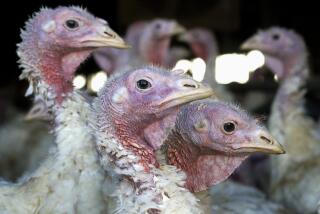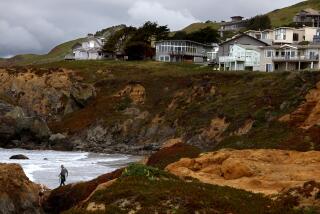Marin’s High Breast Cancer Rate to Be Studied
- Share via
SAN RAFAEL — Four national health agencies will soon try to answer a question that has mystified Marin County residents for years: Why does this community have what appears to be one of the highest rates of breast cancer in the nation?
At a meeting with county health experts last week, federal officials confirmed plans for a joint investigation, drawing on researchers from the National Cancer Institute, the National Institute of the Environmental Health Sciences, the Centers for Disease Control and Prevention and the U.S. Department of Health and Human Services.
Marin’s rate of 223 breast cancers per 100,000 people is sharply higher than the national rate of about 140.
“One needs to look broadly at all the risk factors to see what might be causing these alarming incidence rates,” Carl Barrett, director of the National Cancer Institute’s Center for Cancer Research, said in an interview Friday. “But we don’t come with any preconceived conclusions.”
Barrett said researchers will first organize meetings to analyze the Marin data, and then figure out what additional research is necessary.
Some scientists believe the high rate lies at least partly in the socioeconomic factors that are characteristic of Marin. The county is extremely wealthy, with a per capita income more than 200% of the U.S. average. Forty-four percent of its adults hold at least a bachelor’s degree. BMWs and Volvos dot the driveways of $600,000 homes. Residents shop at organic groceries and run along the shores of the Pacific Ocean to the west, and San Francisco Bay to the east.
These factors would seem to have little relation to a disease that strikes one in eight women nationally. But it’s exactly the attendant perks and habits of such a lifestyle--bearing fewer children, having them later in life, using fertility drugs to conceive them, or taking estrogen and other hormones to alleviate the onset of menopause--that may trigger cancer.
Kenneth Olden, a director of the Institute of Environmental Health Sciences, attended last week’s meeting in Marin: “There was no smoking gun. I didn’t hear anyone talk about a hazardous waste facility nearby or some other environmental thing,” said Olden, a specialist on cancer cell transmission in the body.
“People in Marin are very health-conscious,” Olden said. “They take physical therapy. They take natural products. But just because something is natural doesn’t mean it isn’t carcinogenic.”
Christina Clarke, an epidemiologist with the Northern California Cancer Center, co-wrote a study published in July on the Marin breast cancer rates.
“We have a high distribution of risk factors,” Clarke said, “like delayed childbirth, hormone replacement therapy. These things cluster in affluent, educated women.”
Clarke and a team of doctors and professionals at UC San Francisco, the Lawrence Berkeley National Laboratory, and the county health department found that the breast cancer rate for white, non-Latina women increased 37% from 1990 to 1999 in Marin, but remained flat in the rest of the Bay Area and in California’s other urban counties. (The researchers looked at white, non-Latina women because fewer than 10 cases of breast cancer are annually found in Latinos, blacks or other populations of color in Marin, which is 80% white.)
Even when compared with other affluent or urban areas in California, Marin’s rates still indicate what Clarke and other scientists called “true” anomalies. Marin women aren’t any likelier than other women to get mammograms, which often detect breast cancer at an early stage. So the breast cancer pattern in Marin--where early-stage cancer rates are sky-high, but advanced cancer rates are not any lower--suggests that cases of early detection aren’t supplanting later-stage cases. And Marin’s breast cancer mortality rates are decreasing more slowly than those in other parts of the state, despite women’s access to quality health care.
“You have so many variables, so little understanding, and so much fear in Marin,” said Larry Meredith, director of the county Department of Health and Human Services. “Marin County women are concerned about when, not if, it will occur. That’s what is traumatizing to the community. So we’re looking for the silver bullet.”
In the next week or two, county health officials and experts with the CDC will plot the geographical distribution of breast cancer cases in the county. But Meredith cautions that a draft map shows the rates evenly distributed. He said this blunts easy “smoking-gun” explanations, which a cancer cluster in the immediate environment might have suggested.
More to Read
Sign up for Essential California
The most important California stories and recommendations in your inbox every morning.
You may occasionally receive promotional content from the Los Angeles Times.













